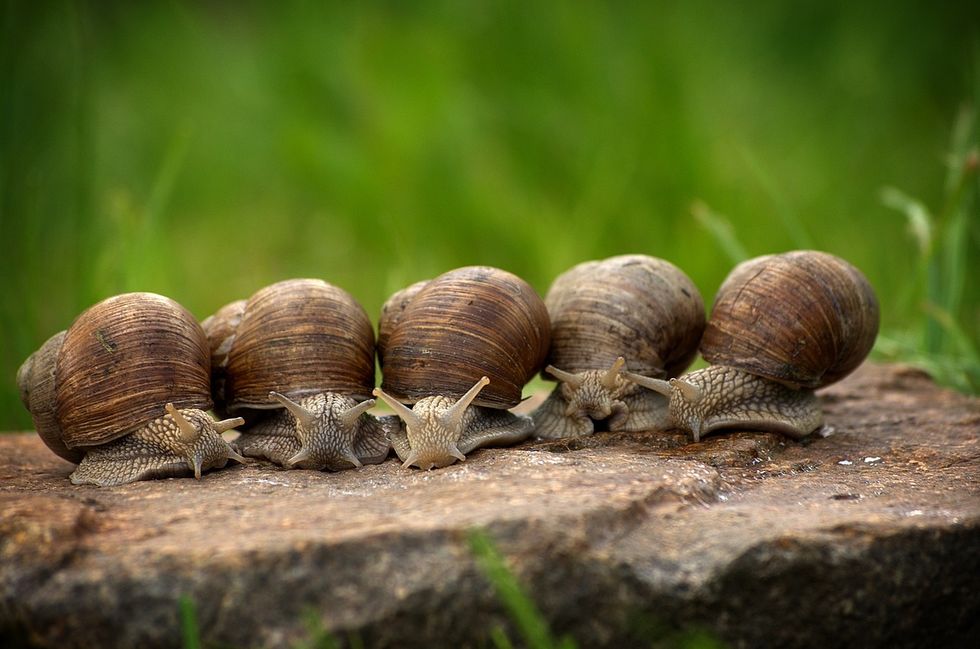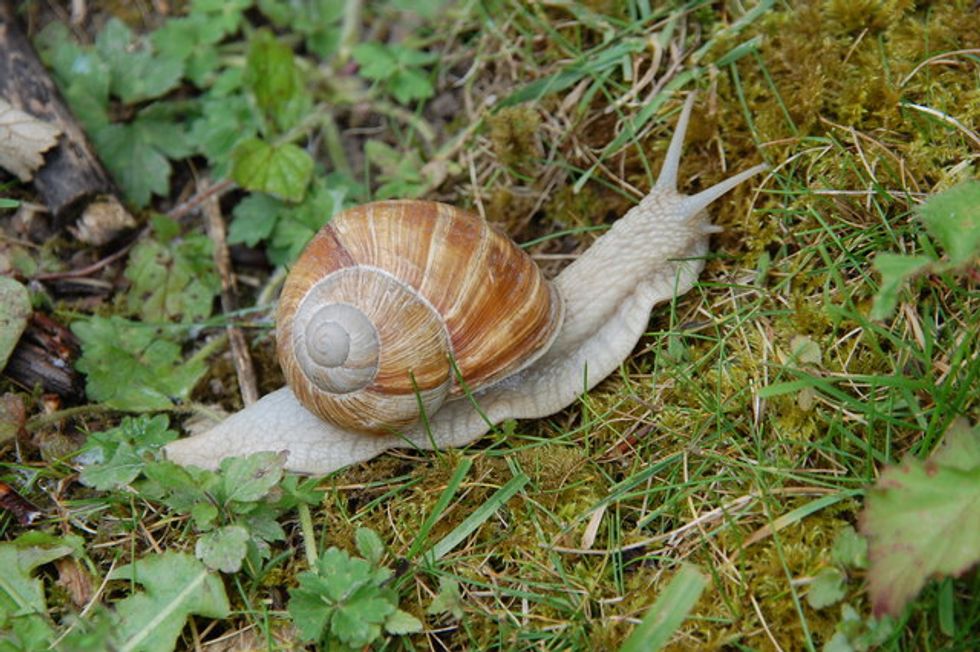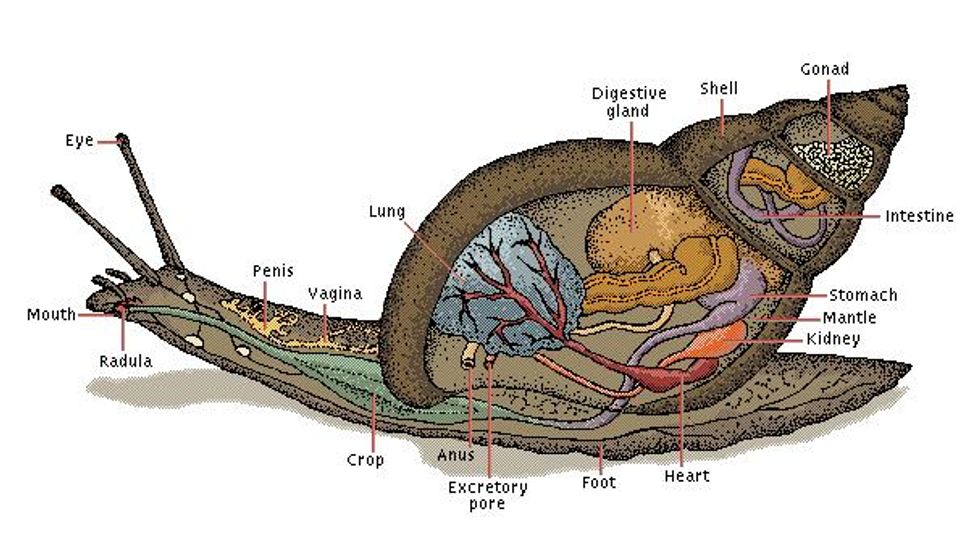Humans have an incurable fascination with speed. Even in the classics, man’s addiction to moving quickly is represented in a metaphor for life:
Men, like runners, pass along the torch of life.
-LUCRETIUS
As a passenger who cannot even stand to go more than 70 miles per hour in a car, I recognize this perverse obsession and realize the only cure is to live more like snails. One might ask, “Why should we act like snails? Snails move so slowly.” To this, I would reply that snails, in actuality, do not move that slowly.
The top speed of a garden snail is 0.03 mph, which only seems slow compared to the relative speed of most human vehicles. They only appear to be moving at a slow speed, but in fact, they are simply taking life slide by slide, a pace we should all long to achieve in our daily movements.
We, everyone, are moving too fast through our lives, which is what makes them seem so short. Snails, in comparison to humans, do not have a long lifespan. However, the short period of five to seven years in which they live feels like an eternity to the snail, because they savor each moment.
There are a few things snails do in their lifetime that create this eternal stretching of time and the appearance of slowness. First, they appreciate nature. Snails live in all sorts of environments, from forests to beaches, and even on farms.
They constantly travel through the wilderness, which is made easy since they carry their homes on their backs. Humans, if they wish to live as the snail does, must also venture into the great outdoors. If they stayed cooped up inside living at the speed of slow, their ingrained impatience would get the better of them. They might snap.
Snails are also safe little creatures. They protect themselves with a shell on their backs and shy away with the slightest touch. However, while they are reserved and can only live alone (a shell’s capacity is, alas, only one snail), they are by no means antisocial beings.
Think of when you lift a rock in a living stream or peer into a shady garden, the many shells you might see verify the herd mentality of the snail. Humans, too, should strive to live with an invisible safety net. We are too bold with our constant search for adrenaline rushes that it can make our lives appear to speed by. By living like snails, we can become more safe and secure while still retaining our social nature; thus rendering our lives to be more than a dress rehearsal for death.
Additionally, snails do not experience the lack of self-confidence that many human beings do. This is because they are never too big, nor too thin; snails can be anywhere from two to twelve inches long, and the largest recorded snail weighed two pounds. Their skin is always moisturized by the mucus they produce to reduce friction while moving. It is impossible for them to have bad hair days without hair. They’re always looking tan, even in the winter. They never have to conform to traditional gender roles, because snails are hermaphrodites.
Living like snails would not only make our lives seem longer; it would make them seem more worthwhile to us as individuals, too.
Man is a fascinating animal, for he is the only species to be concerned with the passing of the days. Snails don’t have watches or calendars. They don’t worry about birthdays or appointments. They cannot measure the time remaining until their demise. Man alone measures time.
He hears it as it comes, counts days, measures the breath.
- CLAUDIAN
…Until it is too late, and then he is dead. He spends his time on this earth counting instead of living, and that makes living pointless. There is but one man I have met who adapted to the life of the snail, and that is the high school English teacher of my junior year.
His slowness was evident by his manner of speech during lectures - crawling along word by word, pondering just how to phrase each sentence before uttering them, gratuitously pausing between rhetorical questions and their answers - and by how long he took to assign and grade our work, at a pace some might describe as 'unbearable.' His students and his coworkers easily grew frustrated because they were impatient little people, conditioned by society to live life at a racing pace.
Human transportation started with walking, then we tamed horses and rode them. Coupled with the invention of the wheel, humans began to find ways to get themselves from one place to another, and quickly at that. There were chariots and wagons, and then steam-powered trains and personal cars, and planes, each being built better, and, more importantly, faster each time.
The origin of the snail is believed to have been around 500 million years ago, and they have not changed much since then. The world of the snail is simple and it changes slowly, but that is just the right speed for the snail. They have lived their time on this planet happily, never wondering if the planet is big enough, or healthy enough, to support them as a species.
The reason snails live so differently than humans, and the reason why they haven’t changed significantly over time is because they have figured life out. In order to be truly happy, every human must endeavor to live a little bit more like the snail each day.
Humans, as a whole, work so incredibly hard to move faster. We push for faster social and political change, we engineer faster jet planes, and we conquer the world with our fast-food franchises.
Take a long look at the people who live this way, dividing their time between McDonald’s and airports; are they healthy? Are they happy? If we took the time to turn off the T.V.s, to hold hands and just embrace the silence of not talking or typing, or walked one day instead of taking the subway, we would be more like the snails of this good, green earth. And who has ever seen an unhappy snail?












































